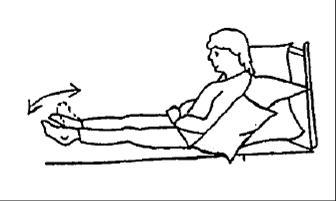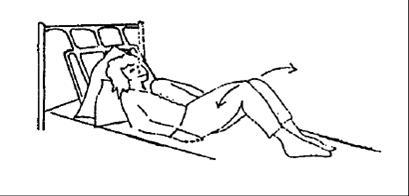Day 1
Circulation exercises are important and should been done hourly. These will reduce the stiffness and swelling in your legs.
- bend and stretch both ankles for 30 secs
- circle your ankles outwards and inwards for 30 secs
- gently bend and straighten your knees one leg at a time

Knee rolling
This is a good exercise after abdominal surgery as it can help relieve wind, which can sometimes cause
discomfort. It will also help reduce stiffness in your back.
- Lying in bed with your head on a pillow and your knees bent up, feet flat. Gently rock your knees from side to side - not too far. Never force movement.

Day 2
You should continue with your day 1 exercises and add in the following ones.
Pelvic tilts
Lying in bed with your head on a pillow and your knees bent up, feet flat. Draw in your tummy muscles and press the small of your back down into the bed. Hold for two seconds and then slowly let go - relaxing your tummy muscles - repeat this 5 -10 times, three times a day. This will help reduce any stiffness in your back.

Hip hitching
Lying on the bed with your head on a pillow. Keep one leg bent- foot flat on the bed and the other one straight out on the bed with your toes facing the ceiling. Make the straight leg longer by pushing heel away from you. You should feel your hip getting a good stretch. Relax your leg slowly and then repeat this on the other side. Repeat this 5-10 times, 3 times a day.
- Do not hold your breath when doing these exercises.
- Do all exercises in moderation and listen to you body.

Exercise Rules
1. listen to your body
2. stop if it hurts or feels strained
3. stop if you are tired
4. never lift both legs together when you are lying (A)
5. never sit up with your legs straight out (B)
6. remember that you have many internal stitches - do not expect too much to quickly

Pelvic floor exercises
The pelvic floor muscles act as a sling and form the floor of the pelvis. They hold up the bladder, womb and the back passage. They also help to control the outlets from the urethra, vagina and back passage. In order to do this these muscles must be strong. If they are weakened you may experience urinary leakage with coughing, sneezing or quickly moving (known as stress urinary incontinence) or a prolapse make occur.

Pelvic floor exercises are essential in keeping these muscles strong and therefore reducing the risk of stress incontinence or prolapse. You can start these exercises before your surgery and then after your surgery once you catheter is removed.
Do not do these exercises if you have a catheter or if you are struggling to pass urine.
How to exercise your pelvic floor muscles
- Imagine that you are trying to stop yourself breaking wind while at the same time trying to stop yourself passing urine.
- You may feel both your front and back passages closing- this is normal.
- Try to hold for 5 seconds, continuing to breathe normally, and then slowly relax. Repeat this exercise 5 times.
- Now try 5 fast holds, tightening the muscles quickly and then immediately relaxing them. Repeat this exercise 5 times.
- To begin with do not try doing any more than 5 of these at a time as the muscles will probably tire quickly.
- You can exercise these muscles in lying, sitting or standing
- It is recommended that you do these exercises 3 times a day
Rules for pelvic floor exercises
- Try not to hold your breath when exercising
- Don't pull in your tummy or squeeze your leg or buttock muscles.
- Before you cough, sneeze or lift anything, tighten your pelvic floor muscles and relax when you a finished.
This know as the KNACK.
- Try to avoid becoming constipated and don't strain to move your bowel as this can make your symptoms
worse.
- Your pelvic floor exercises should be for life in order to keep your muscles strong. If they are weak initially it can take 3-5 months to build strength.
- Do not do a midstream stop routinely as this may lead to problems passing water.
Advice - after you get home
Early Days - try to avoid any heavy lifting eg hoovering, lifting a full kettle or a bag of shopping. Avoid long periods of standing stil (eg over 30mins). Gradually return to everyday activities. If something feels uncomfortable stop. Don't push through pain but listen to you body.
Driving- depending on your rate of recovery you should not drive before 4-6 weeks. You must consider if:
- Can you concentrate?
- Can you do an emergency stop?
- Can you manoevre comfortably eg look behind you before reversing?
Once you are ready start by driving short distances. Check your car insurance cover: you may need to inform your car insurance company of your surgery.
Sport and activity
- you will be tired after your operation as you body uses energy to heal and recover
- walking - start gradually and slowly increase pace until you can walk at a normal speed without tiring. Slowly increase the distance that you are walking and start on flat ground if possible.
- do not start competitive sport or energetic activity until at least 6 weeks after you surgery.
- swimming is an excellent gentle exercise but check that your wound is fully healed before you begin. Not
before 4 weeks after your surgery.
Housework Tips
Initially you must limit yourself to light duties eg. dusting, watering plants etc. This is due to the reduced strength in the tummy muscles in the initial period.
After two weeks:
- You can start kneeling to make your bed, if it is low. Take it slowly as this is a strenuous activity.
- Iron in small quantities- make sure the ironing board is at an adequate height so that you don't have to bend over.
After 4 weeks:
- Start to hoover only the carpet that you see. Do not move any furniture.
At 6-12 weeks:
- Depending on your recovery you can slowly start to introduce normal housework activities and heavier tasks such as carrying shopping. Build up slowly and listen to your body.
- Remember: Take it easy and mobilise little and often
References:
- Abdominal Hysterectomy - Recovering Well Patient Information Leaflet. Royal College of Obstetricians and Gynaecologists. 2015 (most recent update 10/23).
- Good Practice Statement from the POGP: Driving after gynaecological surgery and Caesarean Section after delivery. June 2017.
- Fit following surgery: advice and exercise following major gynaecological surgery. Published by POGP. Feb 2022.











